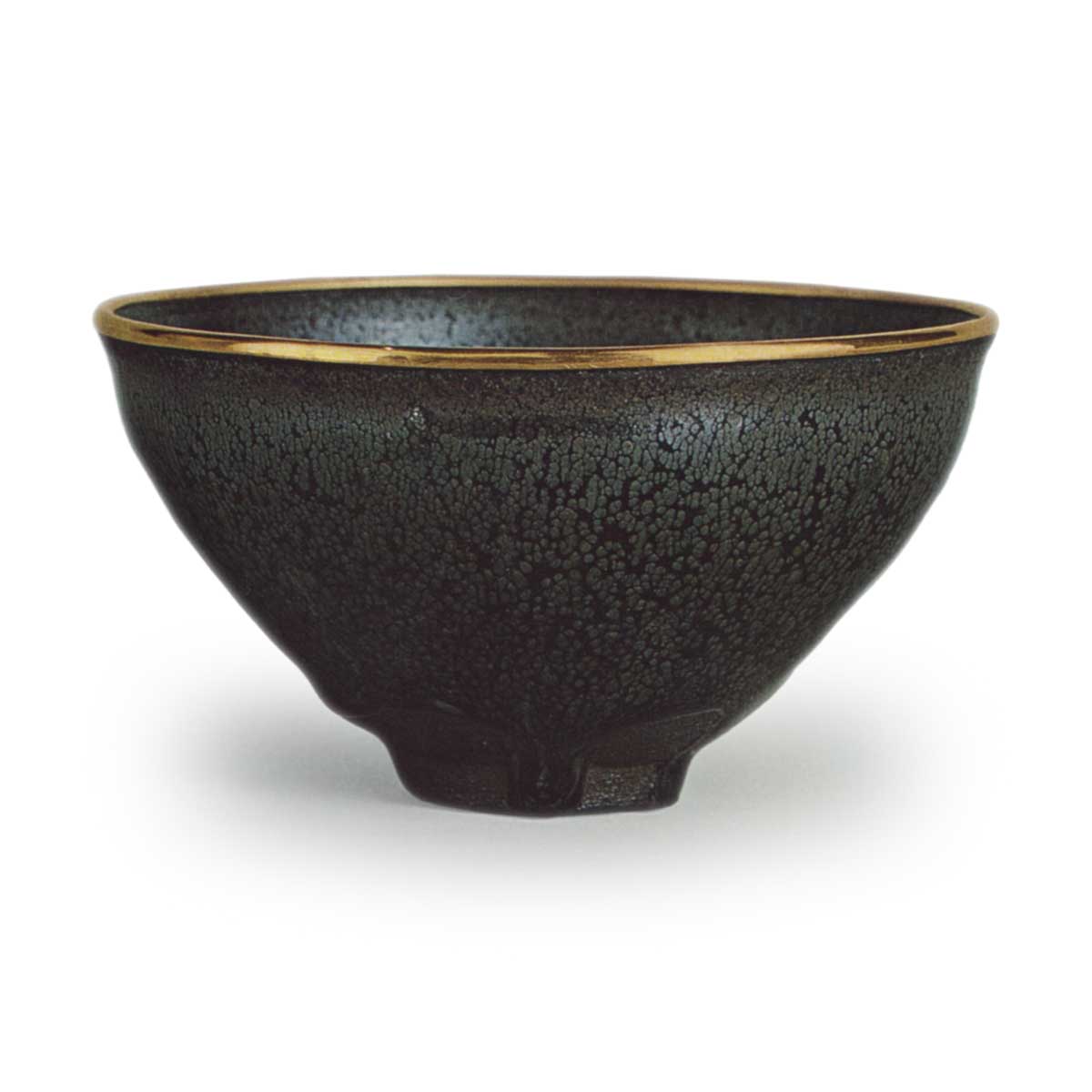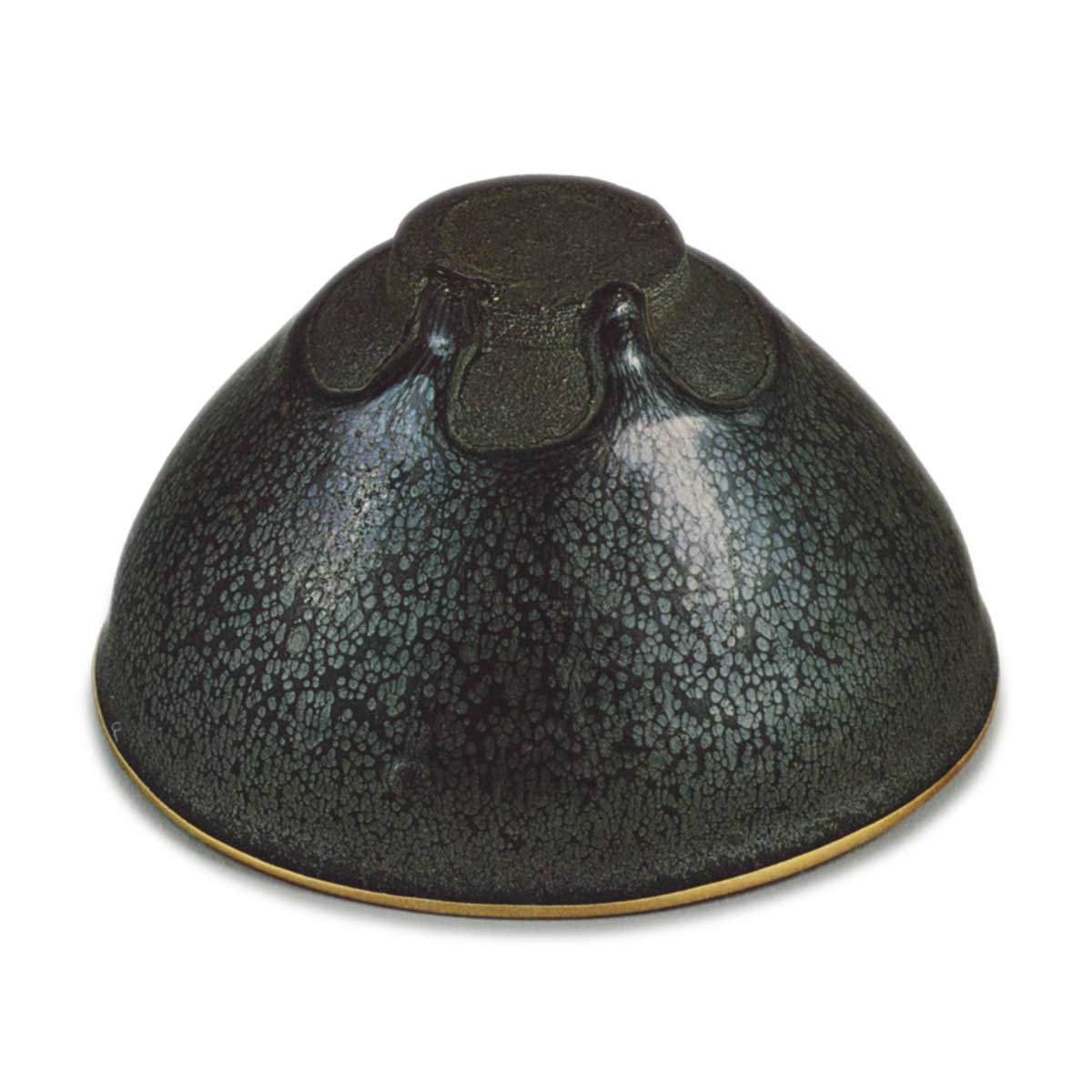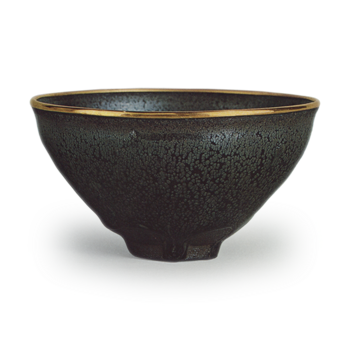

Daimyo-mono
Important Cultural Property
Height: 6.8 – 7.0cm
Diameter: 12.5 – 12.8cm
Foot diameter: 4.0cm
Height: 0.6cm
Of the Yudeki Tenmoku bowls that have been handed down in Japan, this bowl is considered to be the equal of the one that came down in the Wakasu Sakai family, but this bowl is superior in terms of its well-formed shape, while the Sakai bowl is superior in terms of its large, vivid oil spots.
The oil spots on this tea bowl are the most beautiful of all the tea bowls in the Kan’en Tenmoku collection. All the Kan’en Tenmoku tea bowls have a similar simple form, but even within this typological form there are slight differences in size, thinness and fullness, and this tea bowl in particular has a plump body and a generous shape, with a particularly elegant line from the foot to the rim. The silver-iron speckles are a little smaller than those on the Sakai family’s Yudeki, but they appear beautifully across the entire surface of the glaze, like the Milky Way, and the grains on the inside are particularly uniform and beautiful.
The two streams of glaze that run from the foot to the foot ring are clear and distinct, like a picture, and the bowl as a whole is flawless, making it truly the perfect, flawless “true” tea bowl.
After being owned by Furuta Oribe, it was passed on to Doi Oizumi Toshikatsu, and then to Kinoshita Izumi no Kami Nagayasu of Hiji in Bungo Province. From the Kinoshita family, it was passed on to the Matsudaira Fumai family through the intermediary of the Fukamiya Doigai shop in Edo, and remained in the same family until after the Pacific War.
Lord Matsudaira Fumai included this tea bowl in the category of daimyo treasures in his collection, and in September 1811, he wrote the following words of advice to his heir, Dewa-no-kami Narihisa: “This is a famous tea bowl, and it should be carefully preserved for generations to come.”
According to the “Fushimiya Memorandum”, it was said that it was handed over to Lord Fumai for 20 gold coins, but in the “Unshu Meibutsu Ki” it is recorded as “Yudeki 70 ryou”. However, if it was 70 ryou, then it would be a very low evaluation compared to the 500 ryou for the Kizaemon well and the 200 ryou for the Taisho bowl, and if it was 20 ryou, then it would be 20 10 ryou gold coins, making it 200 ryou, the same amount as the Taisho bowl, so perhaps the 20 ryou in the Fushimiya memorandum is correct.
The characters “Yuteki Tenmoku” on the inner box are said to have been written by Sen no Rikyu, and the simple paulownia box is a magnificent box made by Fumai. The bag for the tea bowl is purple habutae, and the inner box is wrapped in chintz. There is also a small white peony bag with gold thread, and on that box, Fumai wrote “Aburadome Furo”. In the “Shokei Meiki Shu” (Collected Works of Various Masters), the writing on the inner box is attributed to Furuta Oribe. Of course, it is thought to have been in the possession of the family before Furuta Oribe, but it is unknown whether it was a Higashiyama Gomotsu (treasured article of the Higashiyama family).
According to the records in the Obian Bunko collection, it is known that a silver border once covered the mouth of the tea caddy, but by the time it was included in the Taisho Meiki Kan, the border was already gone, and the gold border that covers it now was added by the metalworker Nakano Keisho at the request of the current owner when the tea caddy was displayed at the 250th anniversary exhibition of the lord Fumai in Matsue in 1966.



